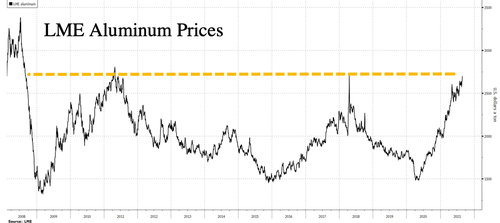What? You forgot the entire rationale for this exercise is to raise prices enough to change behavior?
Regarding aluminum in particular, just as with data centers, all the cheapest spots have already been taken. As coal-fired electricity is phased out we will come to understand why Intel said they would never again build a manufacturing plant in California and have shut down the fabs they had built in their glory days. And why Columbia River hydro was the electricity of choice* for the server farms of Microsoft and Yahoo.
Norsk Hydro with its Årdal smelter and Alcoa Iceland's Fjarðaál smelter use hydro because aluminum smelting is so energy intensive: 15.7 kWh of electricity to produce 1 kg of aluminum.
Russia's Rusal uses cheap gas, and coal as do the Chinese.
And the headline story from ZeroHedge:
Aluminum prices on the London Metal Exchange hit a 10-year high Tuesday, extending a year-long vertical surge as demand rebounds and supply shrinks, as smelters in top producer China faced tougher power controls, stoking supply worries for the energy-intensive metal. Benchmark three-month aluminum climbed 1.8% to $2,696 a tonne in official trading after touching its highest since May 2011 at $2,726.50, and rapidly approaching all time highs around $3,000.
In China, the most-traded October aluminum contract on the Shanghai Futures Exchange closed up 1.2% at 21,390 yuan ($3,311.09) a tonne, hovering near its highest since August 2008 of 21,550 yuan a tonne hit in the previous session.
Aluminum prices have been supported by production curbs in Chinese smelting regions often aimed at easing the strain on the power grid. The latest price surge comes as the government in China's Guangxi region, an aluminum and alumina production hub, on Monday called for tougher controls on energy consumption in a statement issued after a teleconference. The region is China's third-biggest producer of alumina, a primary product of aluminum, with output of 925,500 tonnes in July, according to the National Bureau of Statistics.
A stream of announcements from China about the challenges faced by smelters, combined with soaring global demand, have buttressed prices, said Wood Mackenzie analyst Uday Patel. China's production would still rise this year compared with last year, albeit at a slower pace, he said, adding that its output is about 500,000-600,000 tonnes lower than was expected at the start of 2021.
Meanwhile, Consultancy Mysteel said that eight aluminium smelting companies in Guangxi will have to keep their September production at a maximum of 80% of average monthly output in the first half of the year. That could equate to a reduction in annual operating capacity of 475,000 tonnes, it said.
"The impact of power and production restrictions in Yunnan is still expanding," Huatai Futures said in a report, adding the addition of other production areas to the list was not ruled out. Yunnan, as Reuters reminds us, is an aluminum hub and has seen some smelters forced to cut production due to power curbs this year.
The China Nonferrous Metals Industry Association held a meeting of top aluminum smelters on Monday to address what it described as an "irrational surge" in aluminum prices. Paradoxically, also on Monday, local government officials gathered to discuss cutting output of energy-intensive materials in response to Beijing’s campaign to save power and restrain emissions, according to people familiar with the situation. The meeting followed comments last week from Vice Premier Han Zheng, who called for nationwide curbs on industrial activities that produce too much pollution or fail energy-intensity standards.
The problem is that by further shrinking supply, prices will explode even higher. Amid the confusion, analysts are trying to forecast where the demand and supply curves - both of which are in constant flux - will settle:
"A slew of Chinese policies has recently come to affect aluminum output, pushing prices higher," Wei Lai, an analyst with TF Futures Co., told Bloomberg via phone. "Policies including the power consumption cap are expected to stay through the rest of the year. So the upside momentum remains for aluminum. Prices can hardly retreat as long as demand remains intact."
The metal, which has wide applications in everything from car pates, appliances, defense weapons, airplanes, and even down to the typical soda can, has faced strong demand since the pandemic after global central banks and governments unleashed trillions of dollars in stimulus. Goldman Sachs' Jeffery Currie told clients last week:....
....MORE
*Washington’s Advantage: Electricity Costs
Washington’s north central data center market enjoys the lowest power costs in the nation,
absent subsidies in other jurisdictions. A megawatt of power in Washington can be less than a
third the cost of what it would cost in California – that difference is worth approximately
$800,000 per year per megawatt. On a 5 MW project, that differential is worth $4 million per
year. Data center owners also look at reliability, and Washington’s hydropower is considered to
be highly reliable. Where, as in virtually all competitive markets, sales taxes are not levied on
data center equipment, power represents about 70 percent of a data center owner’s operating
costs, and are therefore a key market differentiator.
An Analysis of Washington’s Competitiveness In This Fast-Growing High-Tech FieldJanuary 2018
